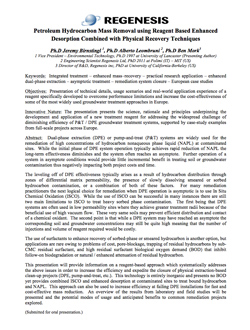PetroCleanze® White Paper
 Petroleum Hydrocarbon Mass Removal using Reagent Based Enhanced Desorption Combined with Physical Recovery Techniques
Petroleum Hydrocarbon Mass Removal using Reagent Based Enhanced Desorption Combined with Physical Recovery Techniques
Dual-phase extraction (DPE) or pump-and-treat (P&T) systems are widely used for the remediation of high concentrations of hydrocarbon nonaqueous phase liquid (NAPL) at contaminated sites. While the initial phase of DPE system operation typically achieves rapid reduction of NAPL the long-term effectiveness diminishes and the system often reaches an asymptote. Further operation of a system in asymptote conditions would provide little incremental benefit in treating soil or groundwater contamination thus negatively impacting both project costs and time.
The leveling off of DPE effectiveness typically arises as a result of hydrocarbon distribution through zones of differential matrix permeability, the presence of slowly dissolving smeared or sorbed hydrocarbon contamination, or a combination of both of these factors. For many remediation practitioners the next logical choice for remediation when DPE operation is asymptotic is to use In Situ Chemical Oxidation (ISCO). While the use of ISCO can be successful in many instances there are still two main limitations to ISCO to treat heavy sorbed phase contamination. The first being that DPE systems are often used in low permeability sites where they achieve greater treatment radii because of the beneficial use of high vacuum flow. These very same soils may prevent efficient distribution and contact of a chemical oxidant. The second point is that while a DPE system may have reached an asymptote the corresponding soil and groundwater concentrations may still be quite high meaning that the number of injections and volume of reagent required would be costly.
The use of surfactants to enhance recovery of sorbed-phase or smeared hydrocarbon is another option, but applications are rare owing to problems of cost, pore-blockage, trapping of residual hydrocarbons by sub-CMC residual surfactant, and high residual surfactant biological oxygen demand (BOD) that inhibit follow-on biodegradation or natural / enhanced attenuation of residual hydrocarbon.
This presentation will provide information on a reagent-based approach which systematically addresses the above issues in order to increase the efficiency and expedite the closure of physical extraction-based clean-up projects (DPE, pump-and-treat, etc.). This technology is entirely inorganic and presents no BOD yet provides combined ISCO and enhanced desorption at contaminated sites to treat bound hydrocarbon and NAPL. This approach can also be used to increase efficiency at failing DPE installations for fast and cost-effective mass reduction. An overview of the results from laboratory and field studies will be presented and the potential modes of usage and anticipated benefits to common remediation projects explored.


 Americas
Americas Europe
Europe Français
Français Deutsch
Deutsch Italiano
Italiano Español
Español


